
Orchids are plants that belong to the family Orchidaceae, a diverse and widespread group of flowering plants with blooms that are often colourful and fragrant. Orchids are cosmopolitan plants that are found in almost every habitat on Earth except glaciers. The world's richest diversity of orchid genera and species is found in the tropics.

Cattleya is a genus of orchids from Costa Rica south to Argentina. The genus is abbreviated C in trade journals.

Laelia is a small genus of 25 species in the orchid family (Orchidaceae). Laelia species are found in areas of subtropical or temperate climate in Central and South America, but mostly in Mexico. Laelia is abbreviated L. in the horticultural trade.

The Chapada Diamantina National Park is a national park in the Chapada Diamantina region of the State of Bahia, Brazil. The terrain is rugged, and mainly covered by flora of the Caatinga biome.

Partula mooreana, common name the Moorean viviparous tree snail, is a species of air-breathing tropical land snail, a terrestrial pulmonate gastropod mollusk in the family Partulidae. This species was endemic to French Polynesia. It is now extinct in the wild.
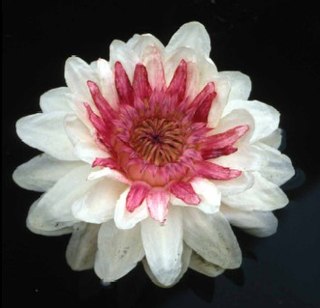
The Flora of Colombia is characterized by over 32,000 species of green plants.
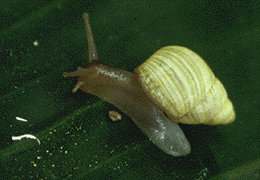
Partula is a genus of air-breathing tropical land snails, terrestrial pulmonate gastropod mollusks in the family Partulidae.

Lepidorrhachis is a monotypic genus of flowering plant in the palm family restricted to Lord Howe Island. The genus name for the single, monoecious species, Lepidorrhachis mooreana, comes from two Greek word meaning "scale" and "rachis", and the epithet honors Charles Moore, first director of the Sydney Botanical Gardens. The common name is Little Mountain Palm.
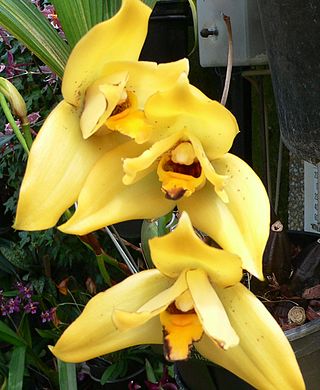
The term grex, derived from the Latin noun grex, gregis, meaning 'flock', has been expanded in botanical nomenclature to describe hybrids of orchids, based solely on their parentage. Grex names are one of the three categories of plant names governed by the International Code of Nomenclature for Cultivated Plants; within a grex the cultivar group category can be used to refer to plants by their shared characteristics, and individual orchid plants can be selected and named as cultivars.
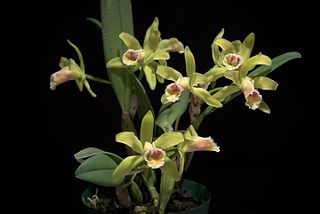
Cattleya luteola is a species of orchid, native to the lowland Amazon rainforest. It is present in Ecuador, Peru, Brazil and Bolivia.

Cattleya maxima is a species of orchid in subfamily Epidendroideae found from Ecuador to Peru.

Cattleya mossiae, commonly known as the Easter orchid, is a species of labiate Cattleya orchid. The white-flowered form is sometimes known as Cattleya wagneri. The diploid chromosome number of C. mossiae has been determined as 2n = 40. The haploid chromosome number has been determined as n = 20.

Cattleya schilleriana is a species of bifoliate Cattleya orchid.
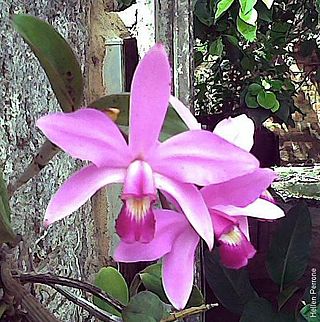
Cattleya violacea is a species of orchid native to the lowland rainforests of the Amazon and Orinoco river basins, being the most widespread of all Cattleya species in the wild. C. Violacea has been found throughout northern South America. Orchids of this species grow on trees along rivers, as they require heat and moisture year round.

Paphiopedilum insigne is an Asian species of slipper orchid and the type species of the genus Paphiopedilum. Its name is derived from the Latin insigne, meaning 'badge of honor' due to the magnificent flower. In the 19th century it was very popular among European and American orchid growers, causing it to become very rare in the wild due to over collecting. There are many varieties of it and hybrids with it.

Cattleya rex is a species of epiphytic orchid of showy white flowers, native to montane forests in Peru and Bolivia.
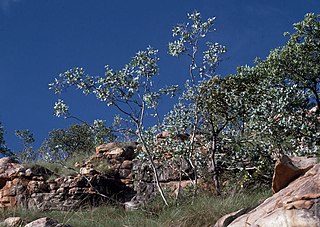
Eucalyptus mooreana, commonly known as Moore's gum, mountain white gum or King Leopold Range mallee, is a species of stunted, straggly tree or mallee that is endemic to the Kimberley region of Western Australia. It has smooth, powdery white bark, a crown of juvenile, sessile, stem-clasping leaves arranged in opposite pairs, flower buds arranged in groups of seven, white flowers and cup-shaped to hemispherical fruit.
The Murici Ecological Station is an ecological station in the state of Alagoas, Brazil. It preserves a rugged area of Atlantic Forest that is important as a home for several species of rare or endangered birds.

Cattleya iricolor is a species of orchid native to the eastern montane forests of Ecuador and Peru.



















